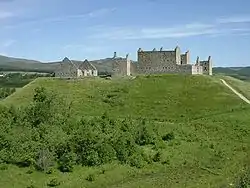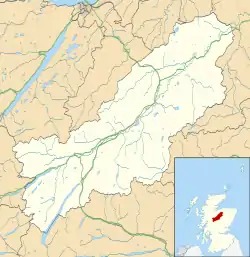Ruthven Barracks
Ruthven Barracks (/ˈrɪvən/), near Ruthven in Badenoch, Scotland, are the best preserved of the four barracks built in 1719 after the 1715 Jacobite rising. Set on an old castle mound, the complex comprises two large three-storey blocks occupying two sides of the enclosure, each with two rooms per floor. The barracks and enclosing walls were built with loopholes for musket firing, and bastion towers were built at opposite corners. Destroyed by Jacobites following their retreat after the Battle of Culloden in 1746, the Barracks ruins are maintained as a scheduled monument by Historic Environment Scotland. They are accessible at all times without entrance charge.
| Ruthven Barracks | |
|---|---|
| Ruthven | |
 Ruthven Barracks | |
 Ruthven Barracks Location within Badenoch and Strathspey | |
| Coordinates | 57°04′20″N 04°2′22″W |
| Type | Barracks |
| Site information | |
| Operator | |
| Site history | |
| Built | 1229 |
| In use | 1229-1746 |
History
First and second castles
The first castle (fortified structure) was built on the hilltop site in 1229,[1] possibly by the Comyns.[2] During the 13th century the castle was held by the Lords of Badenoch, chiefs of Clan Comyn.[3] It was used as a base by Alexander Stewart, Earl of Buchan who was known as the "Wolf of Badenoch", the younger son of King Robert II of Scotland.[1][2] The first castle at Ruthven was demolished in 1451 by John of Islay, Earl of Ross.[2] It was replaced with a second castle, completed in 1459.[1]
From the 15th to 16th century, the castle was held by the Earls of Huntly, chiefs of Clan Gordon, who were then the feudal superiors and lords of Badenoch.[2] The castle was contested during the Wars of the Three Kingdoms and later John Graham, 1st Viscount Dundee, attacked the castle and severely damaged it during the Jacobite rising of 1689.[1]
Jacobite risings
Due to continued unrest, the British government decided to build fortified barracks in strategic locations: the new barracks at Ruthven were completed in 1721 on the castle hilltop. The barracks accommodated 120 troops and 28 horses for dragoons.[1] In August 1745 a unit of 12 soldiers, commanded by a Sergeant Terrence Molloy of the 6th Regiment of Foot, defended the barracks against 200 Jacobites losing just one man, whilst killing at least two Jacobites and wounding many more. The following year Lieutenant Terrence Molloy surrendered to a larger force of Jacobites with two cannons commanded by John Gordon of Glenbucket,[1] after a short siege where the government troops repelled a Jacobite attack, killing many of the Jacobites.
On the day after the Battle of Culloden in 1746, some 3,000 Jacobites retreated to Fort Ruthven but they were sent home by Prince Charles Edward Stuart as their situation was hopeless.[1] The Jacobite army and their leaders had regrouped at Ruthven Barracks where they had waited for word from Charles. His message for them arrived on 20th April in which he stated "let every man seek his own safety in the best way he can".[4][2] The departing Jacobites destroyed the barracks on 17 April 1746.[5] The remnants remain.
References
- "Ruthven Barracks". Undiscovered Scotland. Retrieved 13 April 2014.
- Romantic Badenoch : A Guide Book Compiled For The Benefit of Visitors to The District. Kingussie: J. Johnstone. 1904. pp. 76-78. Retrieved August 22, 2020.
- Tabraham, C.J (1995). Fortress Scotland and the Jacobites. B.T. Batsford and Historic Scotland. p. 14. Retrieved August 22, 2020.
- Tabraham, C.J (1995). Fortress Scotland and the Jacobites. B.T. Batsford and Historic Scotland. p. 91. Retrieved August 22, 2020.
- "Ruthven Barracks". BBC. Retrieved 13 April 2014.
External links
- Ruthven Barracks, Virtual Scotland
